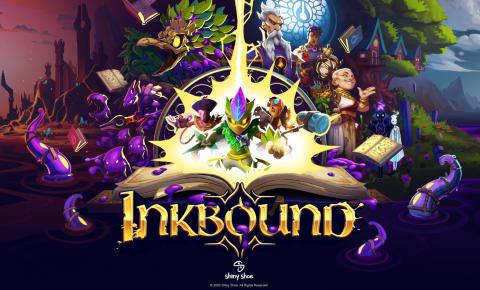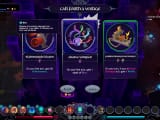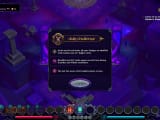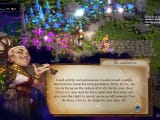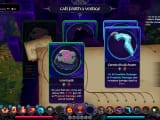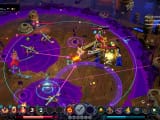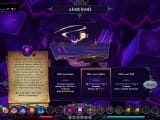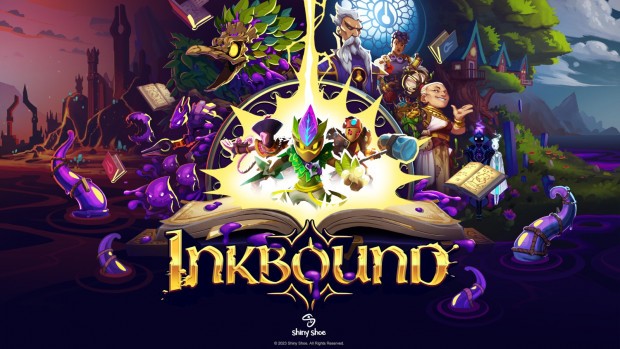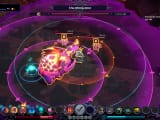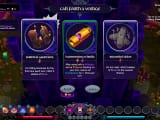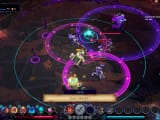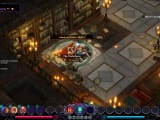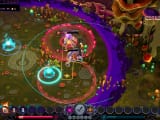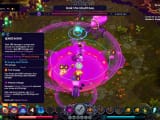Should I go for the Power Orb, which would give my character mana and a chance to launch more attacks before the end of the turn? Or is it a better idea to avoid all enemy attacks by using my entire movement reserve? I chose the latter. I already dealt a lot of damage this turn, and I want to preserve my health, even if it means a longer fight.
The constantly shrinking combat area can be a problem with this strategy. All enemy attacks miss but they crowd around me, meaning my avatar can smash and eliminate one of them and then bonk two skeletons with targets on their heads. I also activate a shield, a useful bit of protection, and pick up another power orb. But my main foe, Janus the Malformed, will reach me with an area-of-effect attack.
A few demon heads spawn and I start to think that trading some movement range for extra attack wasn’t a great idea. A few bonks and a jumping strike destroy more skeletons. But there are enough left that I will only have 2 hit points at the start of the next turn. I’ll probably not survive Janus, but I have some good idea on how to tweak the build for my next run.
Inkbound is developed and published by Shiny Shoe. I played using Steam on the PC and the game is not offered on other platforms. The title combines tactical turn-based combat with a rogue-lite scaffolding.
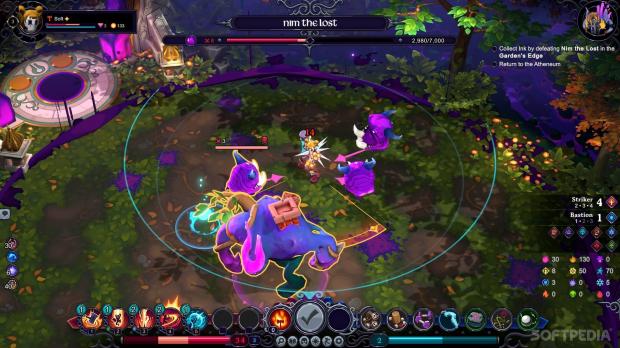
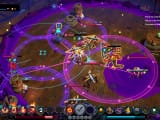
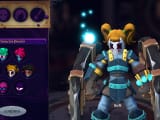
Players become a Needless, born out of ink and destined to join their brethren to protect a world of stories from creeping monsters. To do that they bond with a Kwill, which somehow allows them to tap into the collective mythology of this fantasy world and emulate heroic archetypes from its past. It’s an interesting take on a fantasy universe but the results often struggle to stand out.
The game’s writing, which is driven by genre tropes and attempts at cuteness, might be the biggest problem. I never cared about engaging with the characters in the Atheneum, like the Stigmatist, which tend to exist only to deliver lore and quests. It doesn’t help that other players’ avatars are always there, crowding the space, and limiting the immersion level.
Thankfully, the energy that Inkbound’s creators did not invest in world-building is well spent on an addictive gameplay loop. Players get to choose from four classes, with four more to be unlocked by completing quests, and then it's time to explore a biome, battling enemies, getting upgrades, dealing with events, and potentially getting to a boss encounter.
Combat is turn-based but there’s no grid. Players instead get a circle that shows how far their avatar can move. Mana powers attacks and abilities. The title always delivers full details on what opponents will do on their turn. The challenge is to use this information and a deep knowledge of all available abilities to take as little damage as possible and eliminate all enemies.
Freedom of movement makes it possible to get behind monsters to deliver more damage and shift positions to avoid incoming attacks. There are ways to regain health in Inkbound but a successful run requires conserving HP as much as possible.
Once an arena is clear, players will get to pick up new abilities, called Bindings, or update those they already have. Characters also equip Artifacts and can sacrifice them for extra rewards. Inkbound then asks the player to choose the next node they want to explore. Combat encounters are mixed with areas that feature a store as well as events that offer three choices, each with its own reward.
On death, players get rewards, if they hit a new level, and return to the Atheneum. Then it’s time to see if characters have anything new to say and decide on the class and artifact they will pick for their next run. The game wants players to experiment widely. It’s tempting to stick with a class and find ways to make it overpowered, but I enjoyed the game more when I switched every two or three runs, even if I didn’t make too much progress.
The extensive array of powers, upgrades, and artifacts is the title’s greatest strength. It keeps the frustration level down even when failing to defeat a boss multiple times, because there’s always another tweak to make to a build or another class to try out.
Inkbound also features a daily challenge, which is a good way for players to test out new builds and test their skills. It also has cooperative multiplayer that accommodates up to four players, with each of them acting simultaneously during combat. It is chaotic and benefits from good communication between friends.
Inkbound features a bright and colorful visual universe. The game communicates a lot of information visually, including moves opponents will execute, so pay attention and read the descriptions of powers and artifacts. The graphics are solid but I don’t think characters and enemies, except bosses, are interesting enough, especially when taking into account the cool premise powering this fantasy world.
The game’s interface is very busy but well organized, giving players a simple way to take a look at how their character has evolved and make the best choices in battle. The sound design feels somehow off. The soundtrack is typical for a fantasy world, with little personality, and I turned it down alongside the combat effects. The voice acting is decent.
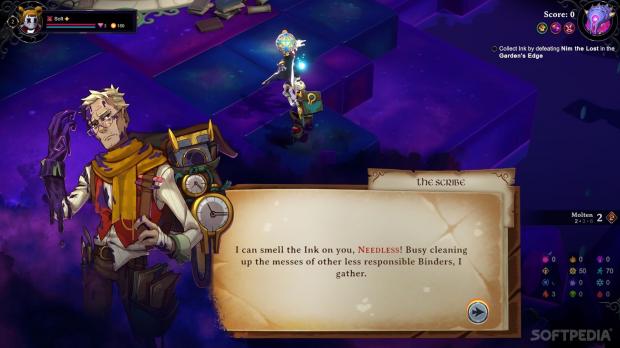
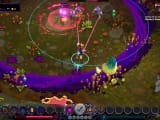
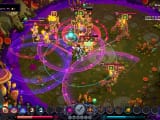
The Good
- Turn-based combat system
- Class and upgrade variety
- Challenging boss battles
The Bad
- Very classic rogue-lite structure
- No big narrative hook
- Forgettable soundtrack and effects
Conclusion
The rogue elements are familiar, and the fantasy world offers plenty of lore but lacks a strong hook. But the turn-based combat is good enough that I can see myself spending tens of hours with one class, trying out ideas to find the build that suits me best. Inkbound’s mix of tactical puzzles and power and upgrade variety makes it a worthy successor to Monster Train.
Review key provided by the developer.
 14 DAY TRIAL //
14 DAY TRIAL // 